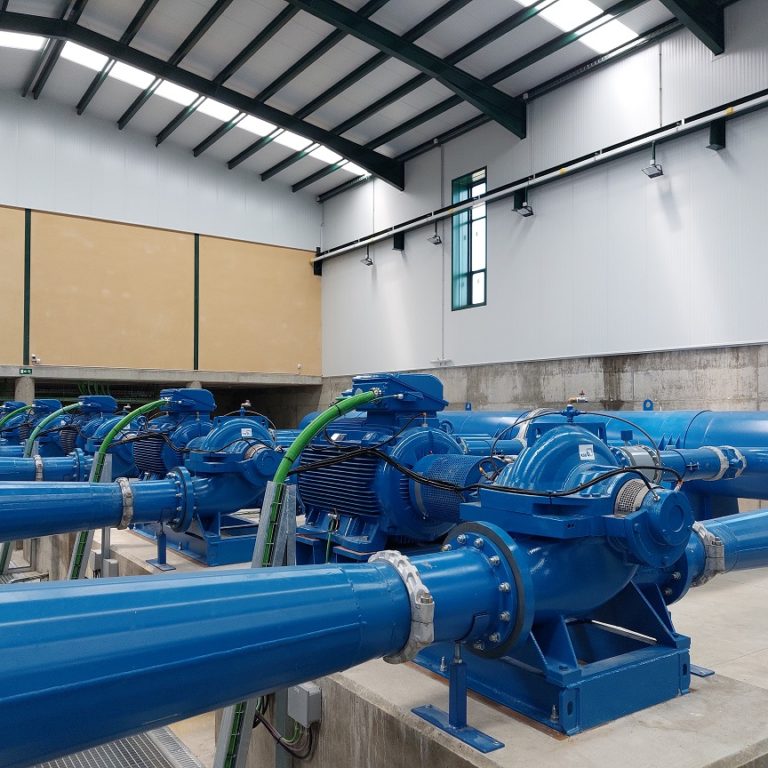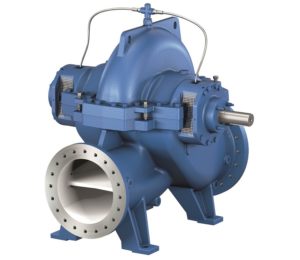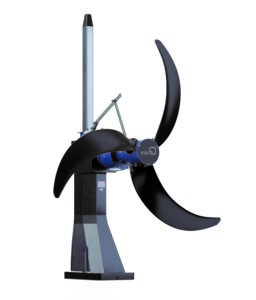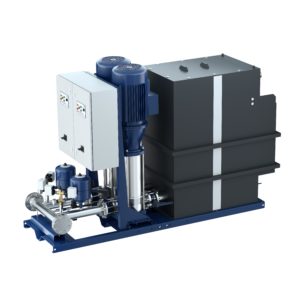KSB Guard and Omega Pumps Combine to Provide Irrigation Benefits to Spanish Farmers

KSB Guard is a monitoring system that identifies how pump maintenance and service can be improved by using digitalisation. (Image source: KSB SE & Co. KGaA)
It also requires strategically located pumping stations and pipeline infrastructure that can be relied upon when called into action.
The Zamora region in the north-west of the province of Castilla y Leon, Spain is one such example of where agricultural irrigation is an essential part of farming life. Close to the border with Portugal, the region is watered by the Elsa, Tormes and Duero rivers. It is cold in winter and hot in summer, making it necessary to water crops during dry periods. Irrigation normally commences in March and continues throughout the growing season.
In 1953 farmers in the region joined forces to form a cooperative to manage the irrigation of their fields more efficiently. Since then, the Páramo Bajo de León y Zamora, through the Comunidad de Regantes del Páramo Bajo, has been responsible for the centrally-operated irrigation programme. Today, the cooperative employs a workforce of around 80 and is responsible for coordinating irrigation across 17,000 hectares of agricultural land. This involves large volumes of water and many water pumps.
Conscious of its responsibilities to the environment by optimising its water consumption for irrigation and maintaining its many pumps, in 2021 the Comunidad Regantes del Páramo Bajo commenced a pilot project designed to address these issues. The project was headed up by pump manufacturer KSB Spain, with whom the Comunidad had long ties through the supply and operation of over 100 KSB Omega pumps installed in pumping stations across the region. Between eight and fourteen KSB Omega pumps operate at the different pump stations, with the number depending on the size of the surface areas being irrigated.
When selecting the sprinkler systems for irrigation, Comunidad del Páramo Bajo has always opted for the modern, sophisticated technologies offered by Omega pumps. KSB’s durable and energy-saving Omega water transfer pump is a horizontal, axially-split volute casing double suction pump. The double entry impeller compensates the axial forces so the load on the maintenance-free bearings is minimal. The combination of solid bearing brackets, a short and rigid shaft and pre-loaded bearings guarantees low vibration and extended operating life for the bearings, seals and coupling. Corrosion and abrasion resistant materials also contribute to long service life by providing protection to key components.
Being an axially-split case pump simplifies maintenance procedures, enabling ready access to all parts for thorough cleaning. The axially split, single stage volute casing Omega pump features a double entry radial impeller and is ideally suited to the requirement of the pumping stations along the irrigation networks as it provides the best duty point and gives operating efficiency levels of above 86%. The interior of the pump has been specifically designed to transport water with the minimum of flow resistance, a factor that also contributes to energy savings and reduced life-cycle costs.
A characteristic of the Omega is its versatility, which is reflected in the large number of hydraulic selection charts, combinations of materials and shaft seal designs, installation options and flange variants. The drive may be positioned on both the left and right of the pump without additional parts or modifications to the casing being necessary.
KSB Guard Pilot Project
Central to the Comunidad Regantes del Páramo Bajo project was the introduction of KSB’s Guard monitoring system as part of a KSBSupremeServ roll-out strategy in the León and Zamora region. First and foremost, the project was aimed at raising awareness of the many benefits that KSB Guard has to offer. The Guard monitoring solution was considered as an ideal complement, with the potential to provide a valuable resource for comparing the status of the pumps at the start of the irrigation period in early March, during the season itself and when it comes to an end.
KSB Guard is a monitoring system that identifies how pump maintenance and service can be improved by using digitalisation. This monitoring device enables bringing existing pumps into to the digital world, even when they are already fully operational. The compact device comprises a sensor unit housing a temperature and a vibration sensor. The vibration sensor has an accuracy of 1 kHz and measures in all three axes. The sensor unit is fastened to the pump (KSB or any other make) using industrial adhesive. This type of fastening is generally suitable for all dry-installed pumps and can even be fitted during pump operation.
The second hardware component is a transmission and battery unit which is connected to the sensor unit with a cable and supplies the sensors with power. This does away with the need to install an additional mains power cable to the sensors at the pump. The batteries have a life of up to five years and are easy to replace.
Using a wireless connection, the data recorded are sent to a gateway, which is the third hardware component. The gateway can be used for up to 20 sensor units and fitted with a SIM card it provides the required connection to the mobile phone network. This means the entire communication path has been defined and secured by KSB, minimising time and costs for installation and commissioning.
To access the available information about a pump, the pump only needs to be assigned in the KSB Guard app or web portal and the name plate data of pump and motor need to be entered. If it is a KSB pump and its serial number is entered, the data will be called up from KSB databases and entered automatically. Even in all other cases, entering the data takes no longer than a few minutes and is as easy as filling in an entry screen in an online shop. There is no further requirement for setting any other parameters. The complete installation and commissioning process is so efficient, it is easy to make existing pumps in a plant smart and, with that, fit for the future.
After commissioning, a multitude of information becomes accessible in the web portal or app. For the Omega pumps the KSB serial number gives access, via app or web portal, to additional documents, such as the data sheet or a sectional drawing, so searching for pump information has become a thing of the past. Quickly and easily maintaining and calling up a history file for the pump is also an option. Any maintenance and repair work can be recorded with a few clicks and will then be visible to all those responsible.
Particularly valuable are the status data of the installed pump sets. They are not restricted to the current temperature and mean vibration velocity values, but also show trends. Since measurements are conducted once an hour or more frequently if needed, data can be examined over time, which enables any changes to the pump status to be identified. Alarm and warning limit values have also been defined for this purpose. If the limit values are reached, an alarm or warning message is triggered. These messages can be received by e-mail or as a push message on a mobile phone or tablet – whichever is most convenient. The limit values can be individually adjusted for each pump using the app or web portal.
Apart from information on the temperature and mean vibration velocity, an operating hours counter, the load profile and the load status of the pump can be displayed. The speed can be derived from the measured vibrations. Initially, this indicates whether the pump is running or at standstill. For pumps without a variable speed system, the speed and an algorithm patented by KSB provide the facility to further identify the load condition of the pump, overload, optimum, part load or extreme part load. In this way KSB Guard also helps to uncover energy saving potentials and optimise plants accordingly.
KSB Guard’s main benefit is certainly that of monitoring the temperature and vibrations and the associated warning and alarm messages, which help identify a change in pump status at an early stage. This allows an early response before any failures or major damage occurs at the pump. The early-warning system has been tried and tested in many applications.
Successful Outcome
KSBSupremeServ technicians needed just one day to fully install the system on the pumps used in the trial and set up everything on a technical level. By using the Guard monitoring system on five Omega irrigation pumps, KSB’s objective was to ensure more effective pump maintenance planning. This now allows the experts at Comunidad Regantes del Páramo Bajo to make valid decisions for the following season and plan preventive maintenance work very precisely for specific needs.
Following the success of the pilot project KSB now has plans to roll out its KSB Guard monitoring solution in other regions of Spain.
Source: KSB SE & Co. KGaA







